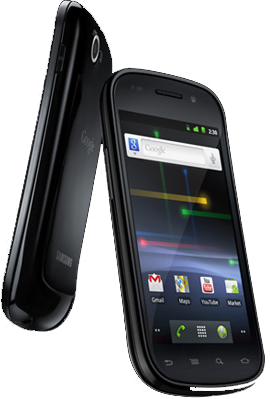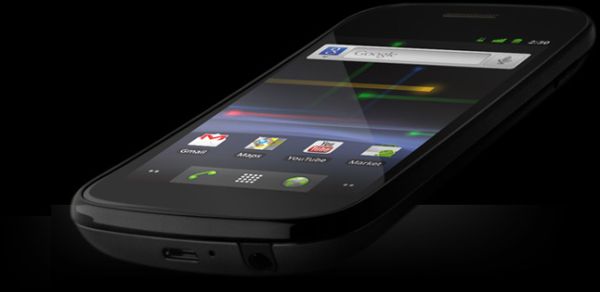A Busy Day for Android - Nexus S and Gingerbread (2.3) Officially Announced
by Brian Klug on December 6, 2010 9:35 PM EST- Posted in
- Smartphones
- Nexus S
- Android
- Mobile
Developer Features
Gingerbread brings a number of developer features and API changes, most notably, improvements to the Dalvik VM garbage collector and event distributor. Google promises smoother gaming with fewer application pauses as a result of the concurrent garbage collection in Gingerbread, and hopefully some of Android's occasional UI stutters will be fixed as a result - the target is to have sub 3ms pauses while Dalvik garbage collects. There are also updated video drivers which improve OpenGL ES performance for faster 3D graphics, but it's unclear which GPUs will get updated drivers. Gingerbread also brings along a Linux kernel update, from 2.6.32 on Android 2.2.1 to 2.6.35 in Gingerbread 2.3.
Gingerbread adds Khronos OpenSL ES sound APi support, and Khronos EGL support for better OpenGL ES texture, surface, and context support. The other changes for developers include better APIs for native input from sensors and adds support for a few more: gyroscope, rotation vector, linear acceleration, gravity, and even barometer sensors are supported. I'd definitely like to see a smartphone with a barometric sensor, given how inaccurate even WAAS-supported GPS is at reporting altitude properly.

The camera API also has been updated to allow for better support for devices with multiple cameras, most notably devices with a front-facing camera.
Finally Google has added VP8 video compression support and WebM container support, Google's own compression standards. There's also new AAC encoding and AMR Wideband encoding for audio capture.
Nexus S
Alongside the Gingerbread software update news came announcement of a new Google-branded device we've already seen a of photos and sneak peaks of, including from Eric Schmidt himself - the Nexus S.

Unlike the Nexus One, Google will not be selling the Nexus S directly, but rather unlocked through Best Buy stores in the US and at Carphone Warehouse in the UK. US availability will start December 16th, and December 20th for the UK. Pricing will start at $529 unlocked and $199 on two-year contract with T-Mobile. The Nexus S has tri-band HSPA support for 900, 2100, and 1700 MHz bands, which means it has 3G support for T-Mobile in the US - AT&T users will see EDGE.
| Nexus S - Network Support | |||||
| Tri-Band HSPA | 900 / 1700 / 2100 MHz | ||||
| Quad-Band GSM/EDGE | 850 / 900 / 1800 / 1900 MHz | ||||
| HSDPA/HSUPA | 7.2Mbps / 5.76Mbps | ||||
The Nexus S is speced similar to the Samsung Galaxy S line of devices - there's a 1 GHz Hummingbird SoC with Imagination SGX540 graphics, 16 GB NAND, 512 MB RAM, 802.11b/g/n, 4" Super AMOLED display, and the usual sensors.
| Physical Comparison | |||||||||
| Apple iPhone 4 | Motorola Droid 2 | Samsung Galaxy S Fascinate | Samsung Focus | Google Nexus S | |||||
| Height | 115.2 mm (4.5") | 116.3 mm (4.6") | 125 mm (4.92") | 122.9 mm (4.84") | 123.9 mm (4.88") | ||||
| Width | 58.6 mm (2.31") | 60.5 mm (2.4") | 64.2 mm (2.53") | 65 mm (2.56") | 63.0 mm (2.48") | ||||
| Depth | 9.3 mm ( 0.37") | 13.7 mm (0.54") | 9.91 mm (0.39") | 9.9 mm (0.39") | 10.88 mm (0.43") | ||||
| Weight | 137 g (4.8 oz) | 169 g (5.9 oz) | 117 grams (4.16 oz) | 119 grams (4.2 oz) | 129 grams (4.6 oz) | ||||
| CPU | Apple A4 @ ~800MHz | Texas Instruments OMAP 3630 @ 1 GHz | 1 GHz Samsung Hummingbird | 1 GHz Qualcomm QSD8250 | 1 GHz Samsung Hummingbird | ||||
| GPU | PowerVR SGX 535 | PowerVR SGX 530 | PowerVR SGX 540 | Adreno 200 | PowerVR SGX 540 | ||||
| RAM | 512MB LPDDR1 (?) | 512 MB LPDDR1 | 512 MB LPDDR1 | 512 MB LPDDR1 (?) | 512 MB LPDDR1 | ||||
| NAND | 16GB or 32GB integrated | 8 GB integrated, preinstalled 8 GB microSD | 2 GB, 16 GB microSD (Class 2) | 16 GB integrated | 16 GB Integrated | ||||
| Camera | 5MP with LED Flash + Front Facing Camera | 5 MP with dual LED flash and autofocus | 5 MP with auto focus and LED flash | 5 MP with autofocus, LED flash, 720P video recording | 5 MP with Autofocus, LED Flash, VGA front facing, 720P Video | ||||
| Screen | 3.5" 640 x 960 LED backlit LCD | 3.7" 854 x 480 | 4" Super AMOLED 800 x 480 | AMOLED 800 x 480 4" | 4" Super AMOLED 800 x 480 | ||||
Where the Nexus S differs is the inclusion of a front facing VGA camera in addition to back 5 MP camera, LED Flash, three-axis gyroscope, inclusion of Bluetooth 2.1+EDR (instead of Bluetooth 3.0 as with Galaxy S), and new hardware onboard for NFC support. It's possible the NFC hardware is integrated into the Bluetooth chipset which would explain the discrepancy, but it's too early to tell.
The Nexus S packs 16 GB of NAND onboard, a large portion of which is partitioned for storage, emulating a microSD card. Gingerbread brings official platform support for devices that lack external storage, instead allowing for internal NAND to be partitioned to emulate a virtual SD card. That appears to be what is done on the Nexus S - there’s no microSD card - but this also has the potential to result in applications loaded to the virtual SD card feeling much snappier than they would be loaded on most microSD cards. I've noticed that even on my Nexus One with a fast class 6 card that applications seem to behave slower on external storage.
What's notable about the Nexus S display is that it is slightly curved. Whereas the Dell Venue Pro has a noticeable convex display in the horizontal dimension, the Nexus S has a subtle but perceptible vertical concave curve. I'm reminded of the Palm Pre's "ergonomic curve" with the Nexus S. In addition, Google notes that the Nexus S definitely has an anti-fingerprint coating.
Of course, the Nexus S ships with Gingerbread installed by default, and takes the Nexus One’s place as the reference device for the Android platform. As usual, expect a full review after we get ours.












45 Comments
View All Comments
Trefugl - Tuesday, December 7, 2010 - link
If you're going to blow $600 on a phone, then why should you need carry around two devices?I would expect my relatively expensive devices to meet my (reasonable) storage requirements either natively or via expansion. I'm not ticked that it's not an option here, but it does affect my decision and I'm leaning elsewhere a little more now.
Bhairava - Tuesday, December 7, 2010 - link
Of course no one is forcing me, dude....but the lack of microsd slot still sucks. Android terminal are better beacouse you can do whatever you want (change battery, expanding storage etc), opposite to the iPhone crap that allows you nothing.Now this is the first step into the wrong Apple-like direction.
Cbac - Tuesday, December 7, 2010 - link
Am I missing something? It sounds like the Nexus S doesn't have a microSD card but is there a reason to think that future native 2.3 phones won't have them either? My impression was that the Nexus One wasn't really all that good of a phone vs. manufacturer/carrier specific models but was appreciated in that you got updates much quicker. Why are people talking about a lack of an SD card on this google phone like it's setting the stage for all the others? I mean don't we know that it's already lacking vs. others in that it's not one of the dual core chips we were expecting? Why should it be any different in respect to the lack of an SD slot?Zoomer - Wednesday, December 15, 2010 - link
Not sure what you are talking about since the Nexus One is a very good device when it came out. Obviously it doesn't beat devices that just came out, but what can?I believe it holds its own even amongst newer devices.
Disclaimer: HTC Desire owner
Why is there a larger form factor, but with the same screen res, less expansion capabilities? The concave thing seems like a gimmicky waste of space.
And I can't believe it doesn't support GSM video calling.
Jodiuh - Monday, December 6, 2010 - link
I'm looking @ a Fascinate right now and it's most certainly not 4" tall.Brian Klug - Monday, December 6, 2010 - link
Samsung lists the following dimensions for the Fascinate: 4.18” x 2.5” x 0.39” here: (add http) samsung.com/us/mobile/cell-phones/SCH-I500RKAVZWI'll have to double check the unit I still have in a second, but I believe the Fasciante is indeed just over 4" tall. ;)
-Brian
craig0ry - Monday, December 6, 2010 - link
I'm curious as to why you think they released this specific hardware configuration, as opposed to waiting for dual-core right around the corner, not to mention the Bluetooth 2.1+EDR... This being the "developer" phone for the Android platform, I'm a little confused as to why they would release this seemingly incremental update versus what waiting for what is sure to be a major revolution for the platform...Any idea what the plan is here with this specific kit?
TareX - Monday, December 6, 2010 - link
Exactly. Let's not fool ourselves: This is a Samsung Galaxy S, with a flash, and a new chip with 0 significant uses.... minus the microSD expansion.ssj4Gogeta - Tuesday, December 7, 2010 - link
Don't forget the curved screen :-Pstrikeback03 - Tuesday, December 7, 2010 - link
Listening to their interviews, it sounds like they use these reference devices in designing the OS. So Google has probably had these around for months, and probably didn't want to wait to have next-gen SoCs before they could make serious progress on the OS. Which could also help explain why they showed off a tablet running Honeycomb at the same time they announced Gingerbread, we might see that even more quickly than the usual gap between version releases for Android.